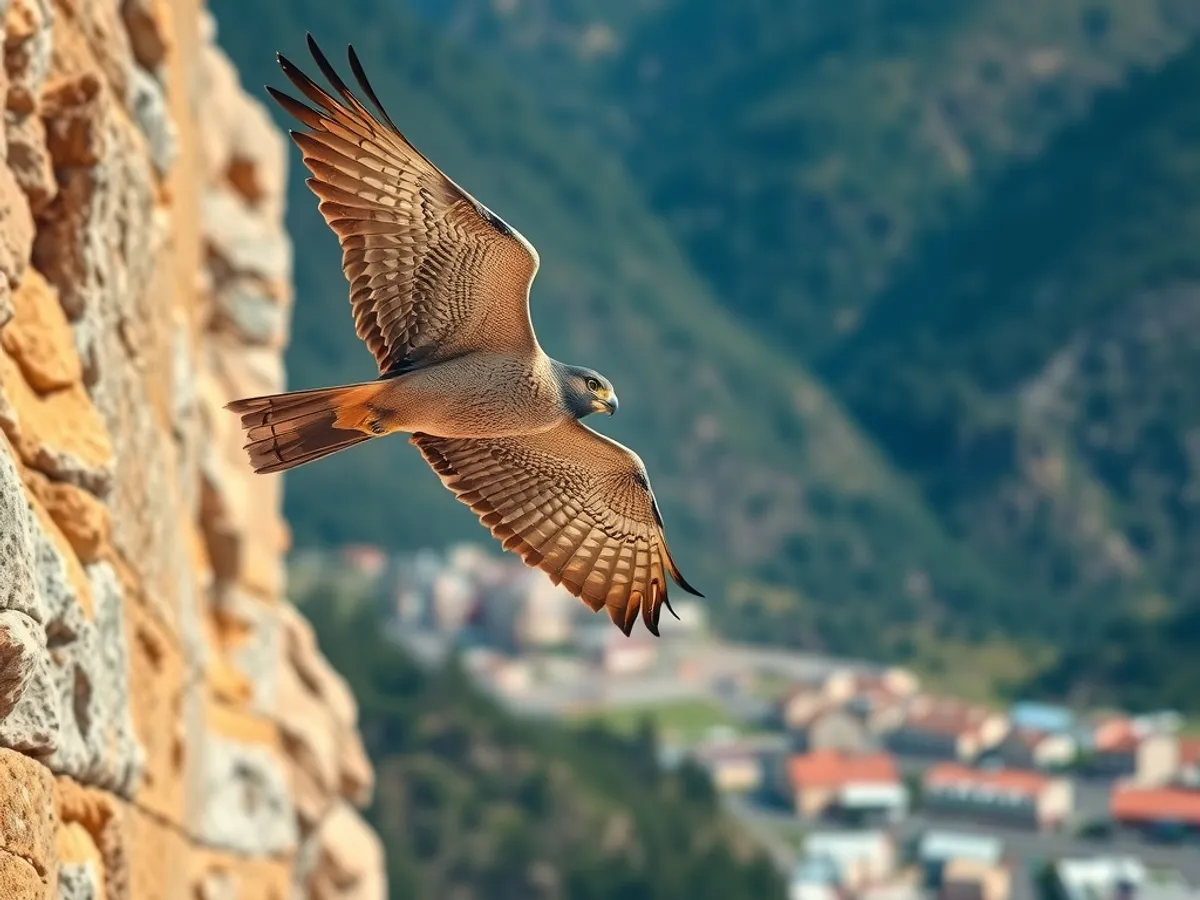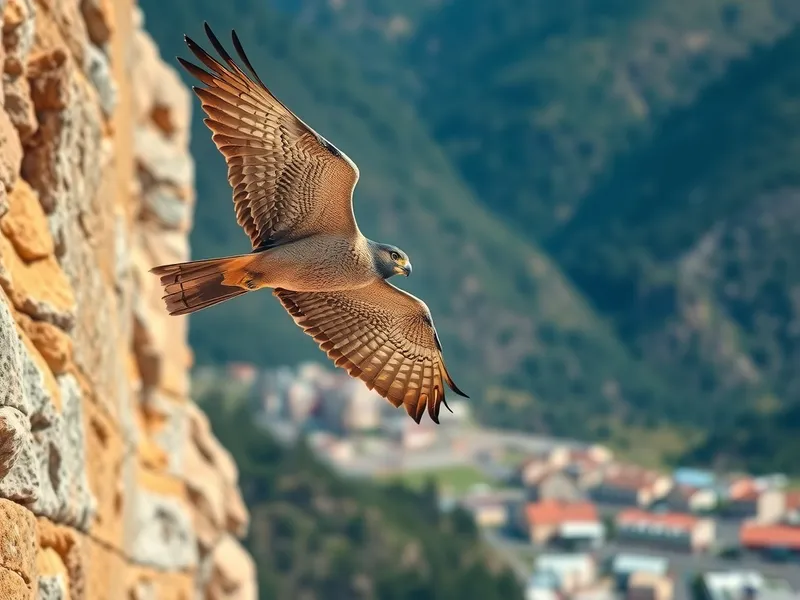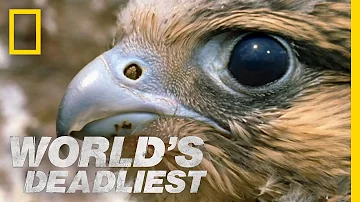
Peregrine Falcon
Falco peregrinus

Meet the Peregrine Falcon
The Peregrine Falcon is a large, powerful bird of prey renowned for its incredible speed and aerial hunting prowess. It has a blue-gray back, barred white underparts, and a distinct black 'moustache' marking on its face. Found on every continent except Antarctica, it thrives in diverse habitats from arctic tundra to urban skyscrapers. Peregrine Falcons primarily hunt medium-sized birds, executing breathtaking high-speed dives called 'stoops' to strike their prey. Once endangered due to pesticide use, their populations have rebounded thanks to extensive conservation efforts.
Classification
Bird
Habitat
Cliffs, mountains, open landscapes, and urban environments
Diet
Carnivore
Lifespan
13-17 years
Conservation
Least Concern
Weight
0.6–1.5 kg
📖Fascinating Facts
Record-Breaking Speed
The Peregrine Falcon can dive at speeds exceeding 320 km/h (200 mph), making it the fastest animal on Earth.
Urban Adaptation
Peregrine Falcons have successfully adapted to city life, using skyscrapers as nesting sites and hunting city-dwelling birds like pigeons.
Exceptional Vision
Their eyesight is estimated to be 8 times better than that of humans, allowing them to spot prey from great distances.
📋Detailed Description
The Peregrine Falcon (Falco peregrinus) is a medium-to-large raptor, measuring 34–58 cm (13–23 in) in length with a wingspan of 74–120 cm (29–47 in), and weighing between 330–1,500 g (0.73–3.3 lb), with females up to 30% larger than males. Its streamlined body, long pointed wings, and stiff, narrow tail are optimized for high-speed flight and agile maneuvering. The plumage is characterized by a blue-grey back, sharply barred white underparts, and a distinctive black malar stripe or 'moustache' below the eyes, which helps reduce glare from sunlight. The beak is short, hooked, and features a tomial tooth—an adaptation for efficiently dispatching prey. Eyes are large and dark, providing exceptional vision, estimated to be 2.6 times sharper than that of humans. Peregrines are highly territorial during the breeding season but may tolerate conspecifics in rich hunting grounds outside of it. They are solitary hunters, relying on acute eyesight and remarkable aerial agility. Their global distribution includes 18–19 recognized subspecies, adapted to a wide range of habitats from sea cliffs and mountains to urban skyscrapers. Peregrines are known for their spectacular hunting stoop, reaching speeds over 320 km/h (200 mph), making them the fastest animals on Earth. Their vocalizations include a series of harsh 'kak-kak-kak' calls, primarily used for communication between mates and territory defense. Lifespan in the wild averages 7–15 years, though some individuals have lived over 20 years in captivity.
💡 Did you know?
Peregrine Falcons have one of the most widespread distributions of any bird of prey, being found on every continent except Antarctica.
🔬Research & Sources
Wikipedia Summary
The peregrine falcon, also known simply as the peregrine, is a cosmopolitan bird of prey (raptor) in the family Falconidae renowned for its speed. A large, crow-sized falcon, it has a blue-grey back, barred white underparts, and a black head. As is typical for bird-eating (avivore) raptors, peregrine falcons are sexually dimorphic, with females being considerably larger than males. Historically, it has also been known as "black-cheeked falcon" in Australia, and "duck hawk" in North America.
Last Modified: 6/5/2025
🎭Behavior & Social Structure
Peregrine Falcons are primarily diurnal, with peak hunting activity occurring at dawn and dusk. They are solitary outside the breeding season, maintaining large territories that they defend vigorously from intruders. Their hunting technique is highly specialized: after spotting prey from a perch or while soaring, the falcon climbs to a great height and then performs a steep, controlled dive (stoop), folding its wings to minimize drag and striking prey mid-air with clenched talons. Diet consists mainly of medium-sized birds such as pigeons, doves, shorebirds, and songbirds, but can also include bats and occasionally small mammals or insects. Peregrines pluck their prey before consumption and often cache surplus food. Social interactions are limited outside of the breeding pair bond, which is typically monogamous and may last for several years. During courtship, aerial displays and food exchanges are common. Peregrines are highly adaptable, thriving in both natural and urban environments, where tall buildings mimic their preferred cliffside nesting sites.
👶Reproduction & Life Cycle
Breeding season varies geographically, generally occurring from February to July in the Northern Hemisphere. Peregrines are monogamous, with pairs often returning to the same nesting site (scrape) year after year. Courtship involves elaborate aerial displays and mutual calling. Females lay 2–5 eggs, typically 3–4, in a shallow scrape on a cliff ledge or tall structure. Incubation lasts 29–33 days, primarily by the female, while the male provides food. Both parents participate in feeding the chicks (eyases), which hatch altricial and covered in white down. Fledging occurs at 35–42 days, but juveniles remain dependent on parents for several weeks as they learn to hunt. Sexual maturity is reached at 1–3 years. Peregrines exhibit high nest site fidelity, and non-breeding 'floaters' may occupy territories if a resident is lost.
🛡️Adaptations & Survival
Peregrine Falcons possess numerous adaptations for high-speed aerial hunting. Their robust, keel-shaped sternum supports powerful flight muscles, while long, pointed wings and a stiff tail provide aerodynamic efficiency and maneuverability. The nostrils contain bony tubercles that disrupt airflow, preventing lung damage during high-speed dives. A specialized nictitating membrane protects the eyes and maintains vision at high velocities. The tomial tooth on the beak allows for rapid severing of the prey's spinal cord. Dense, compact plumage reduces drag and insulates against temperature extremes. Behaviorally, their ability to exploit urban environments demonstrates remarkable ecological flexibility, utilizing tall buildings for nesting and abundant city birds as prey.
🎨Cultural Significance
The Peregrine Falcon has held a prominent place in human culture for millennia. Revered in ancient Egypt and Mesopotamia, it was associated with deities such as Horus. In medieval Europe and the Middle East, peregrines were highly prized in falconry, reserved for nobility and royalty due to their hunting prowess. The species symbolizes speed, power, and freedom, and features in heraldry, literature, and modern conservation success stories. In some cultures, peregrines are considered omens or spiritual messengers. Today, urban nesting pairs are celebrated as icons of wildlife resilience and adaptability.
🔬Recent Research & Discoveries
Recent research has focused on the biomechanics of the peregrine's stoop, revealing sophisticated control of body position and feather orientation to manage airflow and reduce turbulence at extreme speeds. Genetic studies have clarified subspecies relationships and highlighted low genetic diversity in some reintroduced populations. Urban ecology research has documented dietary shifts and breeding success in city environments. Satellite telemetry and GPS tracking have provided insights into migration routes, stopover sites, and habitat use. Ongoing studies monitor the effects of environmental contaminants and climate change on reproductive success and population dynamics.
🎥Wildlife Videos

Fastest Animal Makes a Kill | World's Deadliest
#NatGeoWILD #WorldsDeadliest #Falcons About World's Deadliest: World's Deadliest Predators is a new series that looks at most ...
Nat Geo Animals

Peregrine Falcon: The 320kph Killer Bird | Amazing Animals Series | Real Wild
The "Amazing Animals" series explores the animal kingdom. In this episode, we look at the bird trained to kill, the peregrine falcon, ...
Real Wild

Hunters Of The Skies | Full Episode
Birds of prey are symbols of power, speed and splendour. In fact, there are very few species in the animal kingdom that can be ...
Free High-Quality Documentaries

FALCON VS. EAGLE! WHO IS THE TRUE MASTER OF THE SKY? | Wildlife Documentary | 4K Animal Documentary
Falcons attack, pelicans soar, kestrels hover, owls silently slip, parrots flock, vultures swarm, and eagles swoop. Which one is ...
Docuworld

Peregrine Falcon Attempts to Steal Prey from Osprey
A peregrine falcon, the world's fastest bird, is in hot pursuit of a target. But today's operation isn't a hunt, it's theft - he's spied an ...
Smithsonian Channel

The Peregrine Falcon "a Living Missile"
The Peregrine Falcon "A Living Missile" A clip from the Discovery Channel's "The Savage Edge" #peregrine #birdsofprey ...
WildNature
🌍Habitat Information
The Peregrine Falcon typically inhabits Cliffs, mountains, open landscapes, and urban environments environments. Peregrine Falcons have adapted to their environments with specialized features and behaviors.
Primary Habitat:
Cliffs, mountains, open landscapes, and urban environments
More detailed habitat information will be available soon.
🛡️Conservation Status
The Peregrine Falcon is currently classified as Least Concern. Conservation efforts are crucial for preserving this species for future generations.
Common Threats:
- 🏠Habitat loss and fragmentation
- 🌡️Climate change impacts
- 🎯Hunting and poaching
- 🏭Human-wildlife conflict
⚠️Threats & Conservation Challenges
Historically, Peregrine Falcons suffered dramatic declines due to organochlorine pesticides, especially DDT, which caused eggshell thinning and reproductive failure. Following bans and intensive recovery programs, populations have rebounded in many regions. Current threats include habitat destruction, illegal shooting, collisions with man-made structures, and environmental contaminants such as heavy metals and newer pesticides. Climate change may affect prey availability and migration patterns. Despite these challenges, global populations are stable or increasing, and the species is listed as Least Concern by the IUCN. Ongoing monitoring and management are essential, especially in areas where local declines persist.
🔬Scientific Classification
Scientific Name
Falco peregrinus
Classification Hierarchy
🔍 About Taxonomic Classification
Taxonomic classification is a hierarchical system used by scientists to classify and organize living organisms based on shared characteristics and evolutionary relationships.
The system moves from broad categories (Kingdom) to increasingly specific ones, with each animal's scientific name typically consisting of its Genus and species.
📝Community Notes
Share your observations and insights about the Peregrine Falcon with our community of wildlife enthusiasts.
Join Our Community
Sign in to share your observations and connect with fellow wildlife enthusiasts.
Sign In to ContributeNo community notes yet
Be the first to share your observations about the Peregrine Falcon!
Explore Peregrine Falcon
Select a tab above to learn more about this amazing animal.
📸Photo Gallery
No photos available for this animal yet.
🌟Discover More Wildlife
Continue your journey of discovery with more fascinating animals from our database
